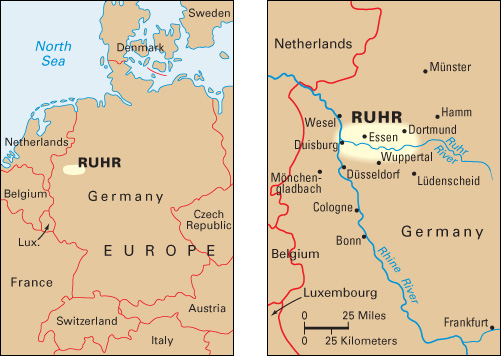Ruhr, << roor, >> is a historic industrial region within the modern Rhein-Ruhr metropolitan area in western Germany. Several tributaries of the Rhine River run through the region, including the Ruhr River, from which the region takes its name. The area known as the Ruhr includes Dortmund, Duisburg, and Essen. The Ruhr covers about 1,000 square miles (2,500 square kilometers). The Rhine-Ruhr area includes such cities as Bonn, Cologne, Düsseldorf, Hamm, Wesel, and Wuppertal.

The people and their work.
The Ruhr is one of the most crowded areas of Europe. The Ruhr has a population of about 5 million people, excluding the Cologne and Bonn areas. Dortmund, Duisburg, and Essen are large industrial cities in the Ruhr.
The Ruhr has one of the largest concentrations of industry in the world. The region’s industries produce chemicals, electronics, iron and steel, and textiles. Service industries, tourism, and cultural and educational institutions are valuable to the Ruhr’s economy. The region also has a dense transportation network that includes canals, highways, railroads, and rivers.
History.
The Ruhr became important to German industry in the mid-1800’s. Its huge coal fields and fine transportation facilities helped it grow as a coal-mining area. In 1871, Germany won control of almost all of Alsace and part of Lorraine after the Franco-Prussian War. The German take-over made iron ore from Lorraine available to German industries without customs duties. Industrialists in the Ruhr began to bring in ore from Lorraine, and the region grew into an industrial center.
Germany lost Lorraine after World War I (1914-1918). For a time, it seemed the Ruhr would again be only a mining district. But the German government paid huge sums to iron manufacturers for the loss of Lorraine. With this money, the industrialists built smelting works that could process iron ore from Sweden.
By 1922, Germany had fallen behind in paying France and Belgium for damages caused during World War I. French and Belgian troops occupied the Ruhr in January 1923 to force Germany to make its payments. But the German government encouraged Ruhr workers to follow a policy of passive resistance and to produce as little as possible during the occupation.
The French took harsh steps to increase German production, but all their measures failed. The decrease in production of the Ruhr soon affected the economic life of France and Germany disastrously. Both countries headed toward national bankruptcy. On Sept. 26, 1923, Germany finally ended its passive resistance in the Ruhr. At the same time, France saw that it was useless to occupy the Ruhr any longer. Under the terms of the Dawes Plan, French and Belgian troops left the region in 1925.
Adolf Hitler came to power in Germany in 1933. He used Ruhr industries to supply the Nazi war machine. During World War II (1939-1945), Allied bombers made many devastating raids on the bridges, cities, and factories of the Ruhr. American armies finally captured the Ruhr, and British troops occupied the area.
After the war, the Ruhr benefited from the creation of the European Economic Community, a forerunner of the European Union that worked to improve economic relations among its members. In the late 1900’s, a number of mines and factories in the Ruhr closed. However, new tourist attractions and increased jobs in service industries and technology helped stabilize the Ruhr’s economy.
